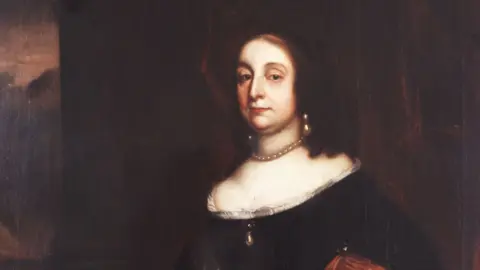Cambridgeshire event aims to shine spotlight on Oliver Cromwell's wife
 The Cromwell Museum
The Cromwell MuseumCivil War re-enactors will parade through a village during a two-day event to shine a spotlight on the life of Elizabeth Cromwell.
The wife of Parliamentarian leader Oliver Cromwell rose to prominence when he became Lord Protector, but returned to obscurity after his 1658 death.
Organiser Clare Strak said the plan was to "put Elizabeth Cromwell firmly back on the map" in her burial place.
It will raise funds for St Andrew's Church, Northborough, Cambridgeshire.
 Cromwell Museum/Simon Hill
Cromwell Museum/Simon Hill John Devine/BBC
John Devine/BBCShe was buried in the church's Claypole Chapel after her death at her widowed son-in-law Sir John Claypole's home, Northborough Manor.
He had been married to the Cromwells' favourite daughter, also named Elizabeth but known as Bettie, who died in 1658, a few weeks before her father.
Ms Strak, chair of the church's fundraising team, said with the restoration of Charles II imminent, Elizabeth "high-tailed" it to Northborough "to do what grandmothers do, which is look after the kids".
"It is wonderful to know that we've got this connection and it's such a shame that Elizabeth Cromwell hasn't been recognised," she said.
 John Devine/BBC
John Devine/BBCUnlike her husband, who left behind more writings and speeches than any other non-royal person before the Victorian period, Elizabeth left little in the way of paperwork.
Born Elizabeth Bourchier, she married Oliver in what was probably an arranged marriage in 1620.
"It was a very happy and devoted relationship. They had nine children and six remained healthy and lived long lives," said Stuart Orme, curator of the Cromwell Museum, Huntingdon.
"Oliver wrote to her when on campaign in 1650 saying, 'Thou are dearer to me than any creature', and she replied, 'My life was but half a life in your absence' - and that was after 30 years' marriage."
Together they weathered financial hardship, Oliver's depression, his conversion to "a born-again Puritan" and their return to financial stability after inheriting an Ely estate.
 John Devine/BBC
John Devine/BBC The Cromwell Museum
The Cromwell MuseumMr Orme said: "When he becomes Lord Protector, she is the supportive wife in the background, and also hosts foreign dignitaries at court. There is no evidence to back Royalist claims she was a Lady Macbeth character.
"From 1658, she goes through a series of shocks - the deaths of husband and daughter, the coup against her son Richard and then her husband's body was exhumed in 1660 and used in an appalling fashion."
A further humiliation must have been the publication in the early 1660s of the Restoration propaganda Mrs Cromwell's Cookbook.
It painted her as "sexually immoral, [a] poor housewife and grasping - all techniques used still today by certain sectors of the media to bring down high-profile women", he added.
Mr Orme will be giving a talk about the book during the weekend's events.
Ms Strak said: "We're immensely proud of our connection to Elizabeth Cromwell and we really do want to remember it."

Follow East of England news on Facebook, Instagram and X. Got a story? Email eastofenglandnews@bbc.co.uk or WhatsApp us on 0800 169 1830
